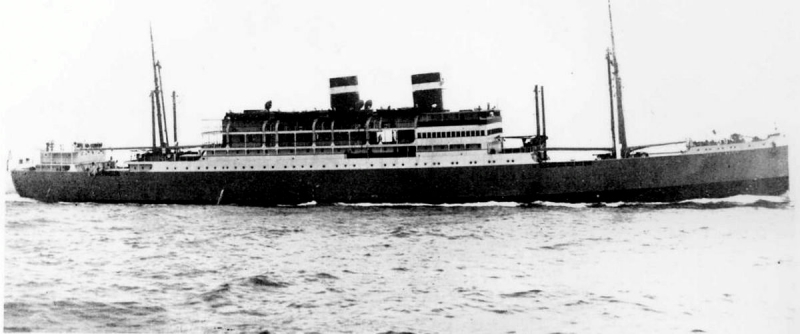Enregistrez-vous
ARMATEURS PASSES
ARMATEURS PRESENTS
NAVIRES MARCHANDS
NAVIRES MILITAIRES
OFF-SHORE
AUTRES IMAGES

| Précedente Suivante |
 |
| Santa Maria |
| Built by: 1927/28 - Furness Ship Building Co, Haverton-on-Tees, England. Yard No 104 7,857 GRT - 8,060 Displacement. Length: 148.14m - 486ft. Width: 19.5m - 64ft. Draft: 7.62m ? 25.1ft. Engines: Two 8-cylinders, 2 Cycle Sulzer (Winterthur) Diesel Engines of 4,000 BHP each, a total of 8,000 BHP. Auxiliary Engines: Four Sulzer Engines at 200rpm - 400BHP. Screws: Twin. Service speed: 17 knots, top speed of 18.5 knots. Passengers: 1928 - 157 First Class Only. 1930 - 172 First Class. The Santa Maria was sold to the US Navy on August 9, 1940 and was send for a refit to Converted by Tietjen & Lang (Todd), Hoboken, N.J. to become a Navy Transport ship for 1,800 troops and she was given the Naval hull number of AP-11. She was fitted with a single 5 inch Gun mount in addition four 3 inch Gun mounts, plus eight .50 Calibre Machine Guns making her ready for anti aircraft defence. But soon enough, in January 1941 the USS Burnett was recalled to Norfolk to be given a far more extensive refit to make her ready for her actual war duties. One of the most notable external changes would be the partial removal of her forward dummy funnel. This was completed on April 3, 1942. Until December returned to participate in amphibious and gunnery exercises with Marines as she had done earlier AP-11 was officially commissioned in Norfolk on September 25, 1940 and renamed USS Barnett. From commissioning until December she was relocated to the Culebra-Vieques Islands and used to train Marines. During World War II USS Barnett operated both in the Atlantic and Pacific, transporting troops, as well as the casualties of war, as well as cargo when required. She provided logistic support during these vital operations: Guadalcanal-Tulagi landings (7-9 August 1942). On February 1, 1943 she had received her camouflage paintwork and was officially reclassified as being an attack transport ship with the new hull number of APA-5 and she was kept very busy during many operations, including: The capture and defence of Guadalcanal, (August 9 and November 28, 1943); the Sicilian occupation (July 10 to 15, 1943); Landings at Salerno (September 9 to 12), the invasion of Normandy (June 6 to 19, 1944), as well as the invasion of Southern France (15 August 14 & September 25, 1944); and the assault and occupation of Okinawa (April 1 to 9, 1945). However, during a bombing attack off the coast of Sicily on July 11, 1943, a bomb burst close to the USS Barnett's port bow abreast of the forward hatch placing a hole in the hull and causing subsequent flooding. Due to this the captain of the Barnett moved the ships ballast and made the ship list to starboard in order to bring the hole above the water line. But sadly seven good men were killed and 35 injured, all being Army personnel. The USS Barnett steamed under her own power to Algiers, Algeria where she would be repaired and arrived on July 15, 1943. After the repairs were completed, she returned to service and she operated on the Pacific until September 26, 1945 when she returned to the United States where she was finally decommissioned on May 21, 1946 at Newport, Rhodes Island. The USS Barnett was awarded ?Seven Battle Stars? for her World War II service, but with her duties now at an end, on July 3 she was transferred to the Maritime Commission, and she was laid up with a countless of other of ships in the James River all awaiting to be sold by auction in due course, which would be in March 1948. |
| Username | |
| Armateur | Grace & Co |
| Ship manager | |
| Numéro IMO | |
| Type de navire | Passenger - Cargo vessel |
| Année et chantier de construction | 1927 - 1928 Furness Ship Building Co, Haverton-on-Tees |
| Date | |
| Lieu | |
| Téléchargée le | 10/12/2016 |
| Dimension | 1200 x 501 |
| visites | 937 |















